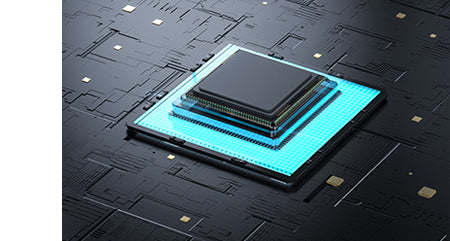
By Ray DeMoss, Support Manager
In the dynamic realm of machine learning, staying ahead of the curve requires not only innovative algorithms, but also cutting-edge hardware. ML Commons, a consortium of industry leaders, has emerged as a pivotal player in this space. In this blog post, we'll explore the significance of ML Commons, with a special focus on its compute and inferencing benchmarks tailored for edge scenarios.
At its core, ML Commons is a collaborative effort among industry giants to establish standardized benchmarks for machine learning tasks. These benchmarks provide a yardstick for evaluating the performance of GPUs, crucial components in the ever-evolving landscape of artificial intelligence.
ML Commons' compute benchmarks delve into the raw processing power of GPUs. These assessments go beyond mere clock speeds and delve into the intricate dance of parallel computations. As we navigate the compute benchmarks, we'll uncover the nuanced capabilities that make GPUs indispensable for intensive tasks, from model training to complex simulations.

The true litmus test for any GPU lies in its ability to perform real-time inferencing, especially in edge computing scenarios. ML Commons' inferencing benchmarks focus precisely on this aspect. Whether it's enabling autonomous vehicles to make split-second decisions, or powering smart cameras for 360-degree situational awareness, the edge benchmarks provide a comprehensive view of a GPU's efficiency in real-world applications.
Why the emphasis on edge computing? As our world becomes increasingly connected, the demand for on-the-spot decision-making is paramount. ML Commons recognizes this trend, and by emphasizing edge benchmarks, it addresses the unique challenges and opportunities presented by decentralized computing.
The benchmarks set by ML Commons are not just technical metrics; they signal a shift in the industry landscape. Companies involved in GPU development now have a standardized framework for showcasing their products' capabilities, fostering healthy competition, and ultimately driving innovation.
In the dynamic landscape of machine learning, ML Commons stands as a beacon of collaboration, setting industry standards for GPU benchmarks. As we explore the intricacies of compute and inferencing benchmarks tailored for the edge, the true significance of these metrics comes to light.
Enter One Stop Systems (OSS), a company committed to pushing the boundaries of computational efficiency. Behind the scenes, OSS' engineering collaborated with cTuning and the ML Commons Task Force on Automation and Reproducibility, utilizing the CLI tools from the Collective Mind (CM) project.

In collaboration with the ML Commons task force, our Rigel Edge Supercomputer system has achieved remarkable results in the inference at the edge category, showcasing the prowess of our flagship server. The benchmarks highlight an impressive throughput of 14,000 samples per second in the BERT natural language model category, paving the way for a new benchmark category in the upcoming MLPerf Inference v3.1 release focused on GPT-J, a large language model.
Navigating the complex landscape of benchmarking required expertise and collaboration. The journey involved leveraging the power of ML Commons' task force tools, led by cTuning, and tapping into the community on their public Discord server.
Our engineering team emphasizes the multifaceted nature of interpreting benchmark results, considering factors such as the model, dataset, quality target, and nuances between single-stream (latency) performance and offline samples per second. Power requirements are also a crucial aspect, with potential exploration into power monitoring systems compatible with ML Perf CLI tools.
As we embark on this project, the collaboration with ML Commons not only reinforces OSS' commitment to excellence, but also positions us at the forefront of technological innovation. Rigel's outstanding performance in ML Commons benchmarks is a testament to our dedication to providing cutting-edge solutions for the challenges posed by modern machine learning applications.
Join us in this journey as we continue to explore the intersections of hardware and benchmarks, contributing to the ever-growing landscape of AI and computational efficiency.
Click the buttons below to share this blog post!

By: Jaan Mannik – Director of Commercial Sales
The term AI, or Artificial Intelligence, is everywhere nowadays and has quietly woven itself into the fabric of our daily lives. It powers the recommendations we see on streaming platforms, the navigation apps that guide us through traffic, and even the virtual assistants that answer our questions in seconds. From optimizing energy use in smart homes to predicting market shifts in finance, AI has become the invisible engine driving convenience, efficiency, and insight across industries.
In manufacturing, AI-driven robots collaborate with humans to streamline production. In agriculture, machine learning models monitor crops, forecast yields, and conserve resources. Retailers use predictive analytics to anticipate consumer needs before customers even express them. The reach of AI is no longer confined to futuristic labs, it’s in our phones, vehicles, and cities, constantly learning and adapting to serve us better.

OSS PCIe-based products deliver critical advantages for modern military sensor systems by enabling real-time data acquisition, processing, and transmission in rugged, mission-critical environments. These benefits stem from their ability to support high-bandwidth, low-latency interconnects, modular scalability, and environmental resilience, all of which are essential for today’s advanced military platforms.

Companies today are being asked to do more with data than ever before. Bigger AI models, faster insights, and workloads that don’t stay in one place, it’s a lot to keep up with. Traditional infrastructure just isn’t built for this kind of speed and flexibility.
The answer isn’t about throwing more hardware at the problem. It’s about building smarter, more agile infrastructure that adapts as demands change. And that’s where scale-out and increasingly, a blend of scale-out and scale-up come into play.